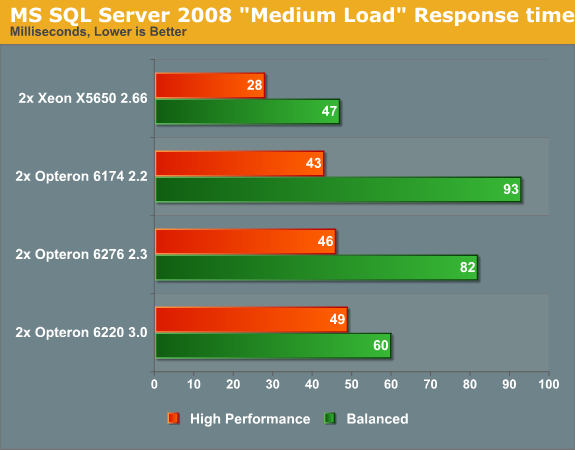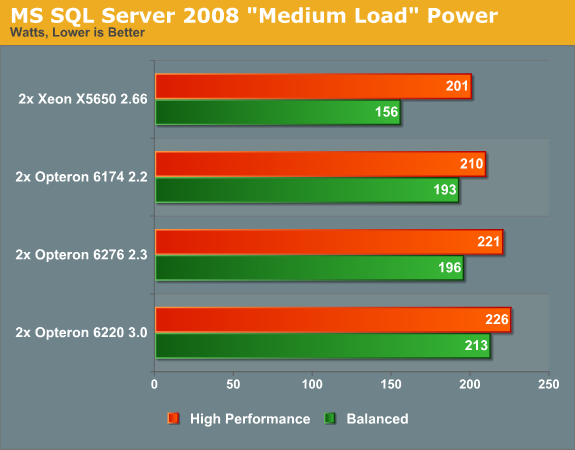The Opteron 6276: a closer look
by Johan De Gelas on February 9, 2012 6:00 AM EST- Posted in
- IT Computing
- CPUs
- Bulldozer
- AMD
- Opteron
- Cloud Computing
- Interlagos
MS SQL Server 2008 R2 at Medium Load
First we test at a moderate load (20-40% load) with 125 concurrent users. Note that these numbers are one set of results from our testing a complete chain of concurrencies (25, 40, 80, 100, 125, 200, 300 ... concurrent users). You will see the complete listing of the results later in the review. For this overview, we focus on a specific concurrency. The database is "warmed up" with a test using 25 concurrent users. We always discard the result at 25 concurrent users as you see some disk I/O peaks at the first concurrency.
We don't look at the throughput numbers here as all servers deliver somewhere between 117 and 122 queries per second as we only demand 125 queries per second. Instead, we focus on response times.

Here the response times are very interesting. From the "full load" numbers, you might conclude that the Opteron 6220 is untenable, as it delivers 30-40% lower throughput while consuming just as much power as the other servers. From those same numbers, we would conclude that the Opteron 6174 is the server platform to get. Switch to a moderate load and our conclusions change.
When testing at medium load, we get a much more accurate and nuanced picture as your servers will probably be spending a lot of time running this kind of load. It seems that if you want to save some power (e.g. run the "Balanced" power profile), the opteron 6220 comes close to the new champion, the Xeon X5650. Since turbo is not enabled in this mode, the 6220 leverages its higher clockspeed to outperform the other Opterons.
Interestingly, the Dynamic Voltage Frequency and Voltage Scaling (DVFS) of the Opteron 6174 performs pretty badly compared to the Xeon and the new Opteron. Enabling DVFS increases the response times by 116% (!) on the older Opteron. The Xeon and Opteron 6276 also get a significant—but lower—hit in response time: +66% and +78% respectively.
The Opteron 6220 suffers much less from this problem, as response times only grow 22%. That clearly indicates that the new Opteron deals much better with DVFS. The reason why the 6276 gets such a high penalty in "Balanced" mode is probably due to the fact that it cannot boost to 2.6GHz or 3.2GHz anymore. A better adapted power policy could definitely improve performance at lower loads. We measured the impact of turbo on the power consumption and it was less than 10%. The energy (power * time) increase was even lower (a few %) as the CPU could put the cores to sleep more quickly.
If you think these kind of response times (<100 ms) don't matter, don't forget that the top 5% queries can easily show 20-50x higher response times. Those are exactly the queries the users might start to complain about.
Let us look at the power figures.

As the Xeon is able to put its cores to sleep more quickly and deeply, the Xeon is a real winner in "Balanced" mode. But notice how the Opteron 6174 performance/watt is no longer attractive: it needs just as much power as Opteron 6276 in balanced mode but delivers worse response times. Meanwhile, the Opteron 6220 fails to impress; it did deliver very decent response times, but it needs 26% more power than the Xeon, which is saving a significant amount of power in "Balanced" mode.










46 Comments
View All Comments
Scali - Saturday, February 11, 2012 - link
"It also reduces throughput."No, it improves throughput, assuming we are talking from improvement going from 1 physical core to 2 logical cores.
Clearly two logical cores (on the same physical core) have less throughput than two physical cores, but that's obvious since you only have half the hardware.
And that, together with the fact that Intel's SMT chips have far better single-threaded performance to begin with, results in very good performance per die area (you know, that thing that people used to praise AMD GPUs for).
"Yes, it does, via the implementation of all that shared hardware on the chip."
You can't say that, since there is no non-modular version of Bulldozer (just as there is no non-HT version of the Intel architectures).
However, if you compare a 4-core HT architecture with a non-HT architecture, be that a Core2 Quad or a Phenom X4, Intel's transistorcount is clearly in the same ballpark, so HT does not add much in terms of transistorcount.
With CMT we see little or no indication of reduced transistorcount. AMD's 4-module chips are MUCH larger than regular 4-core chips have been. In fact, AMD"s 4-module design is even larger than Intel's 6-core design with HT.
"Two different approaches to the same idea."
I disagree. SMT is a very different idea from CMT (which is a bogus marketing term invented by AMD anyway). CMT is more of a marketing excuse for not having proper SMT, and shows no merit in actual silicon.
"but I don't think we can label one as inherently better than the other yet."
Well clearly we disagree on that then.
I think SMT is clearly inherently better than CMT. SMT has far more flexible sharing of resources than AMD's half-baked approach.
And any theoretical disadvantages (fighting over resources and all that) can be put to bed with benchmarking such as in this review: the disadvantages may exist, but the net performance is unbeatable anyway. A midrange Xeon schools a CMT-based chip of twice the size.
Andexxx - Wednesday, February 15, 2012 - link
Well, there are a lot of factors affecting single-threaded performance in real life. So CMT indeed has its scaling advantages as tests suggested. At least most of the things should be constant when comparing CMT-on and CMT-off, while comparing SMT and CMT on different implementations is not. Lack of single-threaded performance is not a valid point of blaming CMT.If you want to *proof* CMT is a half-baked marketing crap while SMT is the only solution, what you need is a SMT-based AMD BD monolithic core or a CMT-based Intel monolithic module for comparison.
For the transistors counting, well, that's their choice of making such a cache and uncore configuration. You can keep telling 4-module chip is blahblahblah, but in some cases it beats a 4C8T Xeon chips. Transistors is not a big matter from customer viewpoint but just the producer viewpoint. If you want to argue with GPU's performance metrics, GPU is a data-parallel processor with bunch of logic units, while CPU is a latency-sensitive girlfriend of caches. Large amount of cache can make your Performance/mm^2 or Performance/transistors look worse. So trade-offs on the amount of cache should have been done before they started to design the chip.
Scali - Wednesday, February 15, 2012 - link
Well, one of the reasons why AMD's current CPUs have such poor single-threaded performance is because they moved from 3 ALUs per thread to 2 ALUs per thread.This is part of the whole CMT design.
So in that sense, CMT can be blamed for the poor single-threaded performance at least.
And since single-threaded performance is so bad, it is only logical that scaling to more threads is relatively good.
On a CPU with faster single-threaded performance, you run into IO limits sooner (memory, disk etc), so it is more difficult to maintain similar scaling with increased thread count.
The strength of SMT is that Intel did not have to cut any ALUs when implementing HT. Pentium 4 Northwood with HT still had two double-pumped ALUs, like the non-HT Willamette that went before it.
Likewise, Core i7 still has 3 ALUs, like Core2.
Another strength of SMT is that even with one less ALU per 2 threads than CMT, it still reaches similar performance in multithreaded scenarios. CMT can not share these ALUs between threads, while SMT can.
Conclusion: CMT is nonsense.
For the full version, see: http://scalibq.wordpress.com/2012/02/14/the-myth-o...
slycer.tech - Monday, February 13, 2012 - link
If Bulldozer arc really bad, how about this?http://www.marketwatch.com/story/amd-opterontm-620...
Can someone prove this award is a big liar?
duploxxx - Tuesday, February 14, 2012 - link
read the article, the baseline they use for price/performance is based on spec results....lots of companies still use these results to decide on a platform.but then again, benchmarks don't always show the real world value or even hard to compare since many have in house applications that don't scale or scale different like the ones benchmarked in reviews. 90% of the datacenters don't even require more then any midrange cpu, anything above midrange is wasted money and both vendors provide more then adequate solutions to that. It's the human mind that is often blocking sanity. Investing that wasted money in other solutions often provide a better total performing solution.
anti_shill - Monday, April 2, 2012 - link
shill_detector by anti_shill on Monday, April 02, 2012Here's a more accurate reflection of Bulldozer/ interlagos performance, untainted by intel ad bucks...
http://www.phoronix.com/scan.php?page=article&...
But if u really want to see what the true story is, have a look at AMD's stock price lately, and their server wins. They absolutely smoke intel on virtualization, and anything that requires a lot of threads. It's not even close.